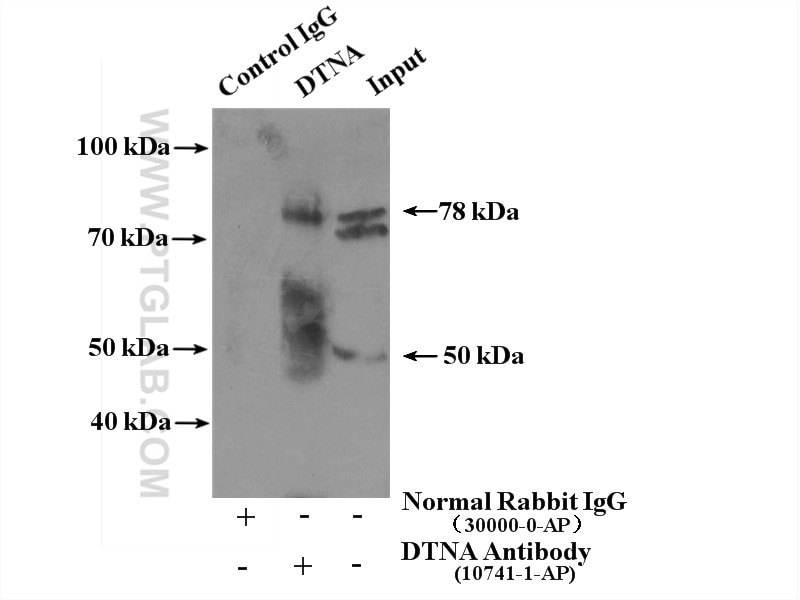DTNA Polyklonaler Antikörper
DTNA Polyklonal Antikörper für WB, IP, ELISA
Wirt / Isotyp
Kaninchen / IgG
Getestete Reaktivität
human, Maus, Ratte
Anwendung
WB, IP, ELISA
Konjugation
Unkonjugiert
Kat-Nr. : 10741-1-AP
Synonyme
Geprüfte Anwendungen
| Erfolgreiche Detektion in WB | Mausherzgewebe, rat heart |
| Erfolgreiche IP | Maushirngewebe |
Empfohlene Verdünnung
| Anwendung | Verdünnung |
|---|---|
| Western Blot (WB) | WB : 1:500-1:1500 |
| Immunpräzipitation (IP) | IP : 0.5-4.0 ug for 1.0-3.0 mg of total protein lysate |
| It is recommended that this reagent should be titrated in each testing system to obtain optimal results. | |
| Sample-dependent, check data in validation data gallery | |
Produktinformation
10741-1-AP bindet in WB, IP, ELISA DTNA und zeigt Reaktivität mit human, Maus, Ratten
| Getestete Reaktivität | human, Maus, Ratte |
| Wirt / Isotyp | Kaninchen / IgG |
| Klonalität | Polyklonal |
| Typ | Antikörper |
| Immunogen | DTNA fusion protein Ag1075 |
| Vollständiger Name | dystrobrevin, alpha |
| Berechnetes Molekulargewicht | 42 kDa |
| Beobachtetes Molekulargewicht | 25, 49-59 kDa, 78-85 kDa |
| GenBank-Zugangsnummer | BC005300 |
| Gene symbol | DTNA |
| Gene ID (NCBI) | 1837 |
| Konjugation | Unkonjugiert |
| Form | Liquid |
| Reinigungsmethode | Antigen-Affinitätsreinigung |
| Lagerungspuffer | PBS with 0.02% sodium azide and 50% glycerol |
| Lagerungsbedingungen | Bei -20°C lagern. Nach dem Versand ein Jahr lang stabil Aliquotieren ist bei -20oC Lagerung nicht notwendig. 20ul Größen enthalten 0,1% BSA. |
Hintergrundinformationen
DTNA (dystorbrevin alpha) is a cytoskeleton associated protein and an essential component of dystrophin protein complex. It is highly expressed in brain, heart and skeletal muscle. Alternative splicing generates several isoforms ranging from 22 to 84 kDa.
Protokolle
| PRODUKTSPEZIFISCHE PROTOKOLLE | |
|---|---|
| WB protocol for DTNA antibody 10741-1-AP | Protokoll herunterladen |
| IP protocol for DTNA antibody 10741-1-AP | Protokoll herunterladen |
| STANDARD-PROTOKOLLE | |
|---|---|
| Klicken Sie hier, um unsere Standardprotokolle anzuzeigen |



